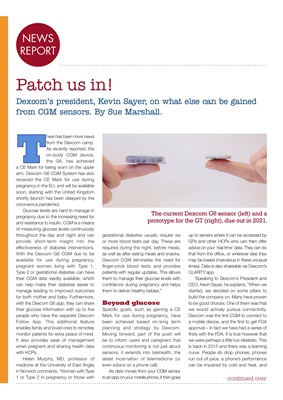
NEWS
NEWS
REPORT
Dexcom's president, Kevin Sayer, on what else can be gained
from CGM sensors. By Sue Marshall.
T
here has been more news
from the Dexcom camp.
As recently reported, the
on-body CGM device,
the G6, has achieved
a CE Mark for being worn on the upper
arm. Dexcom G6 CGM System has also
received the CE Mark for use during
pregnancy in the EU, and will be available
soon, starting with the United Kingdom
shortly (launch has been delayed by the
coronavirus pandemic).
Glucose levels are hard to manage in
pregnancy due to the increasing need for
and resistance to insulin. CGM is a means
of measuring glucose levels continuously
throughout the day and night and can
provide short-term insight into the
effectiveness of diabetes interventions.
With the Dexcom G6 CGM due to be
available for use during pregnancy,
pregnant women living with Type 1,
Type 2 or gestational diabetes can have
their CGM data readily available, which
can help make their diabetes easier to
manage leading to improved outcomes
for both mother and baby. Furthermore,
with the Dexcom G6 app, they can share
their glucose information with up to five
people who have the separate Dexcom
Follow App. This additional feature
enables family and loved ones to remotely
monitor patients for extra peace of mind.
It also provides ease of management
when pregnant and sharing health data
with HCPs.
Helen Murphy, MD, professor of
medicine at the University of East Anglia
in Norwich comments, "Women with Type
1 or Type 2 in pregnancy or those with
Patch us in!
gestational diabetes usually require six
or more blood tests per day. These are
required during the night, before meals,
as well as after eating meals and snacks.
Dexcom CGM eliminates the need for
finger-prick blood tests and provides
patients with regular updates. This allows
them to manage their glucose levels with
confidence during pregnancy and helps
them to deliver healthy babies."
Beyond glucose
Specific goals, such as gaining a CE
Mark for use during pregnancy, have
been achieved based on-long term
planning and strategy by Dexcom.
Moving forward, part of the push will
be to inform users and caregivers that
continuous monitoring is not just about
sensors, it extends into telehealth, the
latest incarnation of telemedicine (or
even advice on a phone call).
As data moves from your CGM sensor
to an app on your mobile phone, it then goes
up to servers where it can be accessed by
GPs and other HCPs who can then offer
advice on your 'real time' data. They can do
that from the office, or wherever else they
may be based (marvelous in these unusual
times). Data is also shareable via Dexcom's
CLARITY app.
Speaking to Dexcom's President and
CEO, Kevin Sayer, he explains, "When we
started, we decided on some pillars to
build the company on. Many have proven
to be good choices. One of them was that
we would actively pursue connectivity.
Dexcom was the first CGM to connect to
a mobile device, and the first to get FDA
approval - in fact we have had a series of
firsts with the FDA. It is true however that
we were perhaps a little too idealistic. This
is back in 2015 and there was a learning
curve. People do drop phones, phones
run out of juice, a phone's performance
can be impaired by cold and heat, and
continued over
The current Dexcom G6 sensor (left) and a
prototype for the G7 (right), due out in 2021.